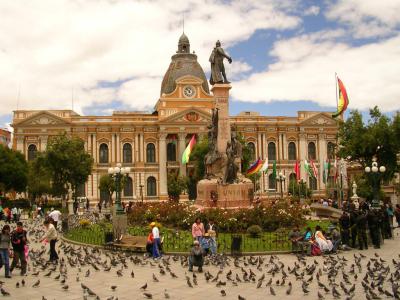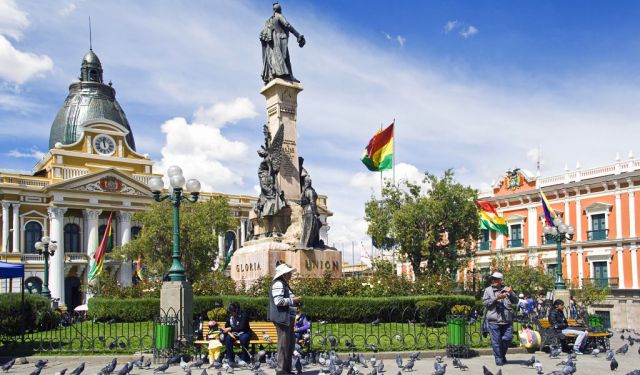Plaza de Murillo (Murillo Square), La Paz (must see)
Murillo Square stands as the main square of the city and serves as the seat of government for the country. The plaza gained significance as the center of Bolivia's political power following the transfer of the Executive Branch to La Paz after the Federal War of 1899. Its history dates back to the early days of the city's founding.
The plaza was designed on the opposite side of the Choqueyapu River, a considerable distance from the main square in Churubamba, where Alonso de Mendoza initially founded the city. The layout of Murillo Square adheres to the Spanish city planning tradition, characterized by a checkerboard pattern with symmetrical, rectangular blocks of equal dimensions.
During the 19th century, the Main Square in La Paz became the epicenter of political power and the primary stage for public life. Surrounding the square were the buildings housing the main institutions of the city. The Council of La Paz, located in the southeast corner (now the Government Palace), the Main Church in the west corner (now the cathedral), and the Royal Treasury facing the Council (now the Prefecture). The Barracks stood on the north side (now Café París).
Notable residents, such as Francisco Tadeo Diez de Medina, occupied impressive homes in the plaza, including the Palace located at the corner of Comercio and Socabaya streets. This palace, constructed in 1775, later became known as the Palace of the Counts of Arana and currently houses the National Museum of Art. The square was also a hub for daily activities, with mestizo and indigenous merchants setting up stalls to offer goods from overseas.
Plaza Murillo played a vital role as a meeting point and a bridge between different social groups, including the local elite and the popular Spanish, Creole, mestizo, and indigenous sectors. It served as a focal point for civic and religious ceremonies, as well as a bustling marketplace where diverse communities came together.
Today, Plaza Murillo continues to be a significant symbol of political power and a gathering place for the people of La Paz. Its historical and cultural importance, along with its architectural beauty, make it a must-visit destination for anyone seeking to understand the rich heritage and diverse social fabric of Bolivia.
The plaza was designed on the opposite side of the Choqueyapu River, a considerable distance from the main square in Churubamba, where Alonso de Mendoza initially founded the city. The layout of Murillo Square adheres to the Spanish city planning tradition, characterized by a checkerboard pattern with symmetrical, rectangular blocks of equal dimensions.
During the 19th century, the Main Square in La Paz became the epicenter of political power and the primary stage for public life. Surrounding the square were the buildings housing the main institutions of the city. The Council of La Paz, located in the southeast corner (now the Government Palace), the Main Church in the west corner (now the cathedral), and the Royal Treasury facing the Council (now the Prefecture). The Barracks stood on the north side (now Café París).
Notable residents, such as Francisco Tadeo Diez de Medina, occupied impressive homes in the plaza, including the Palace located at the corner of Comercio and Socabaya streets. This palace, constructed in 1775, later became known as the Palace of the Counts of Arana and currently houses the National Museum of Art. The square was also a hub for daily activities, with mestizo and indigenous merchants setting up stalls to offer goods from overseas.
Plaza Murillo played a vital role as a meeting point and a bridge between different social groups, including the local elite and the popular Spanish, Creole, mestizo, and indigenous sectors. It served as a focal point for civic and religious ceremonies, as well as a bustling marketplace where diverse communities came together.
Today, Plaza Murillo continues to be a significant symbol of political power and a gathering place for the people of La Paz. Its historical and cultural importance, along with its architectural beauty, make it a must-visit destination for anyone seeking to understand the rich heritage and diverse social fabric of Bolivia.
Want to visit this sight? Check out these Self-Guided Walking Tours in La Paz. Alternatively, you can download the mobile app "GPSmyCity: Walks in 1K+ Cities" from Apple App Store or Google Play Store. The app turns your mobile device to a personal tour guide and it works offline, so no data plan is needed when traveling abroad.
Plaza de Murillo (Murillo Square) on Map
Sight Name: Plaza de Murillo (Murillo Square)
Sight Location: La Paz, Bolivia (See walking tours in La Paz)
Sight Type: Attraction/Landmark
Guide(s) Containing This Sight:
Sight Location: La Paz, Bolivia (See walking tours in La Paz)
Sight Type: Attraction/Landmark
Guide(s) Containing This Sight:
Walking Tours in La Paz, Bolivia
Create Your Own Walk in La Paz
Creating your own self-guided walk in La Paz is easy and fun. Choose the city attractions that you want to see and a walk route map will be created just for you. You can even set your hotel as the start point of the walk.
La Paz Introduction Walking Tour
Nestled like a jewel within the cradle of the Andean highlands, over 3,500 meters above sea level, La Paz, Bolivia, is the most elevated capital city in the world. Curiously, it is one of Bolivia's two capitals (the other one is Sucre).
La Paz was founded on the site of a small Inca settlement, in 1548, by the Spanish conquistador Alonso de Mendoza, and was originally named Nuestra Señora... view more
Tour Duration: 2 Hour(s)
Travel Distance: 2.8 Km or 1.7 Miles
La Paz was founded on the site of a small Inca settlement, in 1548, by the Spanish conquistador Alonso de Mendoza, and was originally named Nuestra Señora... view more
Tour Duration: 2 Hour(s)
Travel Distance: 2.8 Km or 1.7 Miles
La Paz Monuments Tour
They say monuments are the grappling irons that bind one generation to another, symbolizing the country's aspirations, its past, and its character. The monuments in La Paz do exactly that, holding profound cultural, historical, and symbolic value.
The prominent statue of Pedro Domingo Murillo in Plaza Murillo commemorates the key figure of the La Paz revolution of 1809, one of the chapters... view more
Tour Duration: 1 Hour(s)
Travel Distance: 0.8 Km or 0.5 Miles
The prominent statue of Pedro Domingo Murillo in Plaza Murillo commemorates the key figure of the La Paz revolution of 1809, one of the chapters... view more
Tour Duration: 1 Hour(s)
Travel Distance: 0.8 Km or 0.5 Miles





